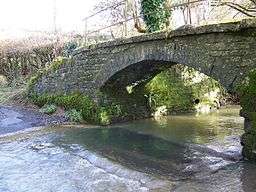Whitelake River
| Whitelake River | |
| River | |
 Cockmill Bridge and ford | |
| Country | England |
|---|---|
| State | Somerset |
| Source | |
| - location | Pylle |
| - coordinates | 51°08′30″N 2°33′47″W / 51.14167°N 2.56306°W |
| Secondary source | |
| - location | Beard Hill |
| - coordinates | 51°09′43″N 2°32′28″W / 51.16194°N 2.54111°W |
| Source confluence | |
| - location | Worthy Farm, Pilton, Somerset, England |
| - coordinates | 51°09′21″N 2°35′24″W / 51.15583°N 2.59000°W |
| Mouth | River Brue |
| - location | Westhay, Somerset, England |
| - coordinates | 51°10′47″N 2°47′41″W / 51.17972°N 2.79472°WCoordinates: 51°10′47″N 2°47′41″W / 51.17972°N 2.79472°W |
| Length | 10 km (6 mi) |
The Whitelake River is a small river on the Somerset Levels, England.
The river rises between two low limestone ridges, part of the southern edge of the Mendip Hills. The confluence of the two small streams that make the Whitelake River is on Worthy Farm which is the site of the Glastonbury Festival between the small villages of Pilton and Pylle. It flows west for approximately 10 kilometres (6.2 mi) until it joins the River Brue at Westhay.
In the 1st millennium BC the land close to the confluence of the Whitelake River River Brue was the site of the Meare Pool which was located on low-lying levels just north of Meare. Its precise boundaries varied according to season, and, over the longer term, as efforts were made to drain the area. In early times the Meare Pool collected the waters of the rivers Brue and Sheppey, and discharged in a northerly direction into the Lower River Axe.[1] In the later years of the 12th century the Abbey diverted the Brue to flow westwards, perhaps largely through natural channels, from Meare Pool to join the river Parrett.[2] Further reclamation was carried out in stages between about 1620 and 1740, with the "new Cutts" (or Decoy Rhyne) being built about 1660. The rivers Sheppey and Hartlake were canalised into the River James Wear and Division Rhyne sometime in the late 1730s.[3]
During 2010 Michael Eavis received a donation from British Waterways of timber from the old gates at Caen Hill Locks in Wiltshire. This was used to construct a new bridge over the Whitelake River which was dedicated to the memory of Arabella Churchill.[4]
References
- ↑ Bulleid, Arthur; Gray, Harold St. George. The Meare Lake Village. Taunton: privately published. pp. 1–14. Archived from the original on 2012-06-27.
- ↑ Dunning, Robert, ed. (2004). "A History of the County of Somerset". British History. pp. 1–7. Retrieved 2008-11-04.
- ↑ Havinden, Michael (1982). The Somerset Landscape. The making of the English landscape. London: Hodder and Stoughton. pp. 161–162. ISBN 0-340-20116-9.
- ↑ Owen, Julian (18 June 2010). "Heart of Glasto". Venue. 924: 14–15.